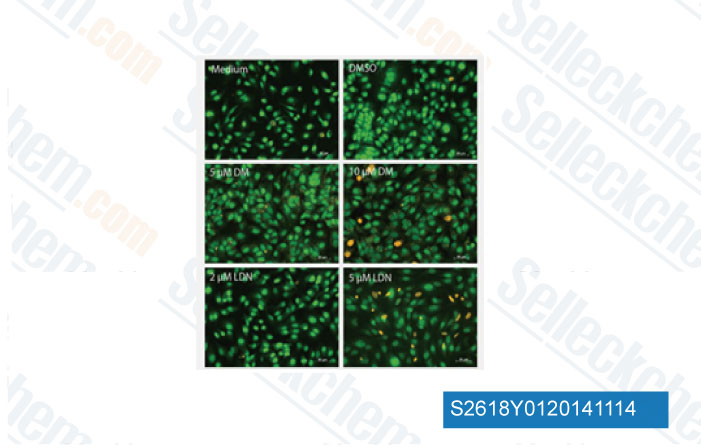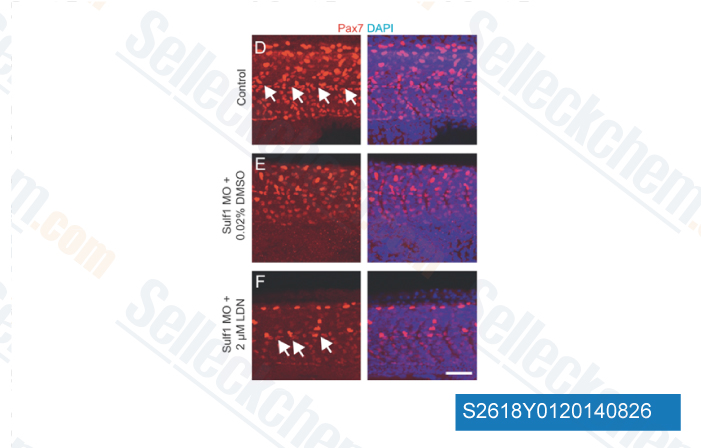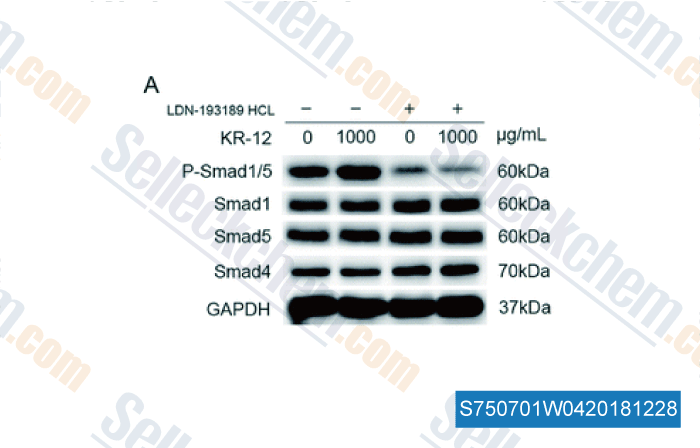|
Toll Free: (877) 796-6397 -- USA and Canada only -- |
Fax: +1-832-582-8590 Orders: +1-832-582-8158 |
Tech Support: +1-832-582-8158 Ext:3 Please provide your Order Number in the email. |
Technical Data
| Formula | C25H24Cl2N6 |
||||||
| Molecular Weight | 479.4 | CAS No. | 1435934-00-1 | ||||
| Solubility (25°C)* | In vitro | Water | 96 mg/mL (200.25 mM) | ||||
| DMSO | 6 mg/mL (12.51 mM) | ||||||
| Ethanol | Insoluble | ||||||
| In vivo (Add solvents to the product individually and in order) |
|
||||||
|
* <1 mg/ml means slightly soluble or insoluble. * Please note that Selleck tests the solubility of all compounds in-house, and the actual solubility may differ slightly from published values. This is normal and is due to slight batch-to-batch variations. * Room temperature shipping (Stability testing shows this product can be shipped without any cooling measures.) |
|||||||
Preparing Stock Solutions
Biological Activity
| Description | LDN-193189 (DM3189) 2HCl is a selective BMP signaling inhibitor, inhibits the ALK1, ALK2, ALK3 and ALK6 with IC50s of 0.8 nM, 0.8 nM, 5.3 nM and 16.7 nM in the kinase assay, respectively. LDN-193189 inhibits the transcriptional activity of the BMP type I receptors ALK2 and ALK3 with IC50s of 5 nM and 30 nM in C2C12 cells, respectively, exhibits 200-fold selectivity for BMP versus TGF-β. | ||||||||
|---|---|---|---|---|---|---|---|---|---|
| Targets |
|
||||||||
| In vitro | LDN193189 potently inhibits BMP4-mediated Smad1, Smad5 and Smad8 activation with IC50 of 5 nM, and efficiently inhibits transcriptional activity of the BMP type I receptors ALK2 and ALK3 with IC50 of 5 nM and 30 nM, respectively. Furthermore, LDN193189 also shows the inhibitory effect on the transcriptional activity induced by either constitutively active ALK2R206H or ALK2Q207D mutant proteins. [1] A recent study shows that LDN-193189 blocks the production of reactive oxygen species induced by oxidized LDL during atherogenesis in human aortic endothelial cells. [4] |
||||||||
| In vivo | In conditional caALK2-transgenic mice with Ad.Cre on on postnatal day 7 (P7), LDN-193189 (3 mg/kg i.p) leads to mild calcifications surrounding the left tibia and fibula first visible at P13, and prevents radiographic lesions at P15 without causing weight loss or growth retardation, spontaneous fractures, decreased bone density or behavioral abnormalities. [1] LDN193189 dorsalizes zebrafish embryos by inhibiting signaling pathways induced by bone morphogenetic protein (BMP)6 without effect on vascular development. [2] In PCa-118b tumor-bearing mice, LDN-193189 treatment attenuates tumor growth and reduces bone formation in the tumors. [3] In LDL receptor-deficient (LDLR-/-) mice, LDN-193189 potently inhibits development of atheroma. Moreover, LDN-193189 also exhibits the inhibitory effects on associated vascular inflammation, osteogenic activity, and calcification. [4] |
||||||||
| Features | Selective BMP type I receptor inhibitor. |
Protocol (from reference)
| Kinase Assay: |
|
|---|---|
| Animal Study: |
|
References
Customer Product Validation

-
Data from [Data independently produced by Int J Cancer, 2014, 10.1002/ijc.29220]

-
Data independently produced by , 2014, 378:107-121

-
Data from [Data independently produced by , , RSC Adv, 2018, doi:10.1039/C8RA00750K]
Selleck's LDN-193189 2HCl has been cited by 96 publications
| Dissecting peri-implantation development using cultured human embryos and embryo-like assembloids [ Cell Res, 2023, 10.1038/s41422-023-00846-8] | PubMed: 37460804 |
| Electrical stimulation affects the differentiation of transplanted regionally specific human spinal neural progenitor cells (sNPCs) after chronic spinal cord injury [ Stem Cell Res Ther, 2023, 14(1):378] | PubMed: 38124191 |
| Proteomics and disease network associations evaluation of environmentally relevant Bisphenol A concentrations in a human 3D neural stem cell model [ Front Cell Dev Biol, 2023, 11:1236243] | PubMed: 37664457 |
| Proteomics and disease network associations evaluation of environmentally relevant Bisphenol A concentrations in a human 3D neural stem cell model [ Front Cell Dev Biol, 2023, 11:1236243] | PubMed: 37664457 |
| Accelerated differentiation of human induced pluripotent stem cells into regionally specific dorsal and ventral spinal neural progenitor cells for application in spinal cord therapeutics [ Front Neurosci, 2023, 17:1251906] | PubMed: 37781243 |
| Generating Neural Retina from Human Pluripotent Stem Cells [ J Vis Exp, 2023, (202).] | PubMed: 38189566 |
| Primate gastrulation and early organogenesis at single-cell resolution [ Nature, 2022, 612(7941):732-738] | PubMed: 36517595 |
| Stretchable Mesh Nanoelectronics for Three-Dimensional Single-Cell Chronic Electrophysiology from Developing Brain Organoids [ Adv Mater, 2022, e2106829] | PubMed: 35014735 |
| Application of an iPSC-Derived Organoid Model for Localized Scleroderma Therapy [ Adv Sci (Weinh), 2022, e2106075] | PubMed: 35315234 |
| Recapitulating influenza virus infection and facilitating antiviral and neuroprotective screening in tractable brain organoids [ Theranostics, 2022, 12(12):5317-5329] | PubMed: 35910807 |
RETURN POLICY
Selleck Chemical’s Unconditional Return Policy ensures a smooth online shopping experience for our customers. If you are in any way unsatisfied with your purchase, you may return any item(s) within 7 days of receiving it. In the event of product quality issues, either protocol related or product related problems, you may return any item(s) within 365 days from the original purchase date. Please follow the instructions below when returning products.
SHIPPING AND STORAGE
Selleck products are transported at room temperature. If you receive the product at room temperature, please rest assured, the Selleck Quality Inspection Department has conducted experiments to verify that the normal temperature placement of one month will not affect the biological activity of powder products. After collecting, please store the product according to the requirements described in the datasheet. Most Selleck products are stable under the recommended conditions.
NOT FOR HUMAN, VETERINARY DIAGNOSTIC OR THERAPEUTIC USE.
